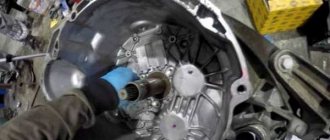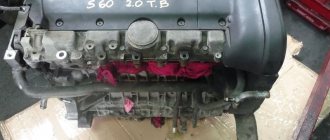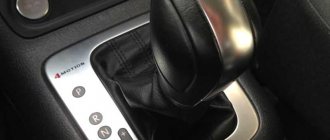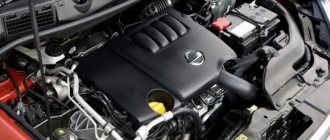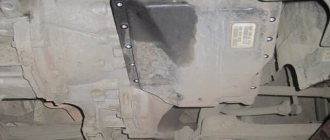What gearboxes are installed on the Ford Focus 3
The third generation Ford Focus has every chance to repeat the glorious path of its predecessors, which are an example of a reasonable price-quality ratio, and therefore have become bestsellers in the Russian automotive market.
The car has been sold in Europe since December 2010, in Russia - since July 2011. The history of the Ford Focus car goes back three generations:
- first generation: 1999-2005, restyling in 2001;
- second generation: 2005-2010, restyling in 2008;
- third generation: 2010-present
Ford Focus 3 is built on the C1 automobile platform, which is used jointly with Ford (models C-Max, Grand C-Max, Kuga) by Volvo (models C70, C30, V50, V40) and Mazda (models 3 and 5). Despite the external differences, these cars are united by many structural elements, including front and rear subframes, suspension, steering, braking system, and active safety systems.
The car belongs to the small middle class (C-class or golf class) according to the European classification. For the domestic automotive market, Ford Focus 3 is produced at a plant in the city of Vsevolozhsk, Leningrad Region, in three body types:
- hatchback (since July 2011),
- sedan (since September 2011),
- station wagon (since January 2012).
The width and height of the car are common to all body types and are 1858 and 1484 mm, respectively. The length of the hatchback is 4357 mm, the sedan is 4532 mm. The ground clearance is standard for a passenger car and is 14 cm.
Cars produced for the Russian market are equipped with four different engines: three gasoline and one diesel. The engines are mounted transversely.
The first in a series Duratec Ti-VCT petrol engine with a volume of 1.6 liters and a power of 105 hp. and a maximum torque of 150 Nm. It is an in-line, four-cylinder engine with DOHC, timing belt drive and four valves per cylinder. The engine has an electronic distributed fuel injection system and a proprietary Ti-VCT variable valve timing system. The declared fuel consumption in the urban, suburban and combined cycles is 8.1/4.8/6.0 liters per 100 km, respectively. Acceleration to 100 km/h takes 12.3 seconds, top speed is 187 km/h.
The next in the line of gasoline units is the Duratec Ti-VCT engine, which, with a volume of 1.6 liters, produces a maximum power of 125 hp. and torque 159 Nm. Structurally, it is also an atmospheric engine, equipped with a variable valve timing system. Fuel consumption indicators are 8.1/4.7/6.0 liters per 100 km (urban/suburban/combined cycle). Maximum speed 196 km/h, acceleration to 100 km/h – 11.0 s.
The most powerful GDI Ti-VCT petrol engine has a cylinder capacity of 2.0 liters and delivers a maximum power of 150 hp. and torque 198 Nm. The engine is equipped with a direct fuel injection system and a variable valve timing system. Unlike other gasoline engines, it has a timing chain drive. Its performance characteristics: maximum speed (with manual transmission) 206 km/h, acceleration to 100 km/h 9.3 s. Fuel consumption in city. in the suburban and combined cycles it is 9.6/5.0/6.7 liters per 100 km, respectively.
The only diesel Duratorg TDCi has a volume of 2.0 liters, from which 140 hp is produced. The maximum torque is 320 Nm. The engine is four-cylinder, in-line, equipped with a turbocharger (variable geometry turbine) and a Common Rail injection system. Injection pressure 200 MPa. The engine is paired with a robotic gearbox, with which it accelerates the car to 100 km/h in 9.5 seconds. Maximum speed 205 km/h. Fuel consumption in the urban, suburban and combined cycles is 6.8/4.4/5.3 liters per 100 km, respectively.
The vehicle's transmission provides drive to the front wheels. The Russian Ford Focus 3 is equipped with a 5-speed manual transmission. The proprietary Power Shift robotic gearbox is used as an automatic transmission. The preselective six-speed robotic gearbox has two dry clutches, providing an almost continuous flow of power. Structurally, the gearbox is similar to the famous DSG gearbox from Volkswagen, but has a lower price. With 105 hp engine robot box is not applicable.
McPherson strut is traditionally used as the front suspension on the Ford Focus. The Control Blade multi-link rear wheel suspension provides improved dynamic performance and handling. The braking system is represented by disc brakes, including ventilated front ones. The steering has an electro-hydraulic power steering EPAS, which provides variable steering force depending on the speed.
The car is equipped with modern active safety systems. The base has an anti-lock braking system ABS and an EBD brake force distribution system. As an option and in a number of standard trim levels, the ESP stability control system is installed; EBA emergency braking system; lifting assistance system; parking sensors and parking autopilot; ACC adaptive cruise control with low-speed collision mitigation; lane change assistance system; speed limiter.
The passive safety of the Ford Focus 3 is represented by a redesigned and reinforced body structure, seat belts with a seat belt detection system, driver and front passenger airbags (in the base) with the ability to disable the front passenger airbag, three-dimensional side airbags, and mounts for installing child seats.
Other useful options on the Ford Focus 3 include remote-controlled central locking, a factory-installed engine immobilizer and alarm system, automatic windshield wipers, a tire pressure monitoring system, and adaptive lighting (automatic low-beam headlights).
What kind of automatic machine is installed on Ford Focus 3
The 3rd generation of Ford cars does not please with the rich choice of equipment for cars with automatic transmission. This transmission is only available with the 1.5-liter EcoBoost engine. Fans of other power units will have to choose the not very reliable PowerShift robot or conventional mechanics.
The 3rd generation Focus is equipped with a 6F35 automatic transmission. This is Ford’s own development together with the General Motors concern, based on the 6T30/6T40 automatic transmission, which was unsuccessful in all respects. The manufacturer has worked hard to eliminate the shortcomings of this transmission and released its 6-speed automatic, which has already been successfully used on Mondeo, Escape, Fusion and Kuga models. Owner reviews of this box are quite good, so the manufacturer decided to use it on the Focus.
New Power Shift transmission
What awaits us when purchasing this car model? Preselective Power Shift transmission with two clutch packs, EcoBoost series turbo engines, electric booster, with the help of which the car parks itself and also adheres to its lane line.
There is even a robotic electronic eye that can recognize the most common road signs. Any car enthusiast will be delighted with such unusual and useful innovations in the Ford Focus 3.
Some even listed this model as a competitor to the Audi A3. A car with an automatic transmission is currently breaking all sales records in Russia. Its popularity is the fruit of the successful work of highly qualified specialists.
The new Focus 3 family of cars is a truly large-scale project by Ford. They are produced in Spain, Thailand, China, Germany, and of course, in the USA and Russia. And this model can be found on sale in 129 countries around the world. Over these 2 years, the car has shown itself excellently and fully met the expectations of both developers and car enthusiasts around the world. Ford Focus 3, which has an automatic transmission, is becoming an even more popular option among other representatives of this class.
How much do these “Tricks” cost?
Although the Ford Focus III model is still quite fresh, for 400 thousand rubles you can find a car with a 1.6 liter and a 2012-2013 model. It will almost certainly be an empty set.
For something more comfortable to drive, for example, with a 2.0 l engine and 150 hp. They will ask you for 630 thousand for 2014.
The new Focus 3, 2021, from the showroom will cost from 900 thousand rubles for the average configuration.
Main technical characteristics
The Ford Focus 3 uses various engine and gearbox configurations. Therefore, the main technical characteristics differ. You can view the parameters of the Ford Focus 3 in the tables below.
Table - Technical characteristics of Ford Focus 3 with automatic transmission
| Engine | Acceleration to 100 km/h, s | Consumption in the city, l | Consumption on the highway, l |
| 1.5 150 l. With. | 9.3 | 8.5 | 4.7 |
| 1.6 105 l. With. | 13.2 | 9.3 | 4.8 |
| 1.6 125 l. With. | 11.8 | 8.7 | 4.9 |
| 2.0 150 l. With. | 9.4 | 9.1 | 4.9 |
Table - Technical characteristics of Ford Focus 3 with manual transmission
| Power unit | Acceleration to 100 km/h, s | Fuel consumption in the city, l | Fuel consumption on the highway, l |
| 1.6 105 l. With. | 12.4 | 8.1 | 4.8 |
| 1.6 105 l. With. | 12.4 | 8.4 | 4.7 |
| 1.6 125 l. With. | 11 | 8.1 | 4.8 |
| 2.0 150 l. With. | 9.3 | 9.6 | 5 |
| 1.6 125 l. With. | 11 | 8.4 | 4.7 |
Reviews of real fuel consumption indicate a deviation from the consumption declared by the manufacturer. If the car has a manual gearbox, then in winter the car requires 1-2 liters more to cover 100 km. With an automatic, actual consumption can reach 12-14 liters per hundred.
Automatic transmission reliability and service life
The 6F35 automatic gearbox is highly reliable. Its repair is rarely required until the mileage has reached 350-400 thousand km. Changing the oil has an important impact on the service life. If the violation of lubrication renewal intervals is accompanied by an aggressive driving style, then a major overhaul of the transmission may be required after 120-150 thousand km.
When replacing transmission fluid, you should be careful when choosing a filter. After modernization in 2012-2013. It received a plastic case. This was done in order to simplify and reduce the cost of the design. The filter is not interchangeable with consumables from earlier years.
The automatic transmission oil filter is disposable. Its maximum service life is 100-150 thousand km. The service life of the machine box directly depends on the filter. Therefore, it is recommended to change it every 80 thousand km. It is recommended to shorten the installation interval for a new filter element when critical loads occur on the automatic transmission or when there is significant wear on the clutches.
The 6F35 automatic transmission is sensitive to oil temperature. When cold, the lubricant thickens. The occurrence of increased loads, for example, a sharp start, can damage the automatic transmission after 3-15 thousand km. For this reason, during winter operation of the Ford Focus 3, it is recommended to warm up not only the power unit, but also the transmission. To do this, move the automatic transmission selector several times to all positions with the engine running.
When changing the oil, it is important to monitor its level. The 6F35 automatic transmission does not have a dipstick. You need to check the oil level using the overflow plug. A systematic deviation in the smaller or larger direction of the volume of transmission fluid in the box leads to the end of the automatic transmission life at a mileage of 80-130 thousand km.
At a mileage of 160-200 thousand km, problems occur with the selector. The automatic transmission stops responding to driver inputs. The reason for this is damage or oxidation of the contacts.
When the mileage reaches 200 thousand km, the torque converter causes problems. A burnt smell from the oil indicates burning and abrasion of the friction pack. Teflon rings also wear out significantly. Problems in the torque converter are always accompanied by the appearance of deposits in the valve body.
With a mileage of over 100 thousand km, the automatic gearbox begins to lose oil, which seeps through the seals and gaskets. A decrease in lubricant volume has a negative impact on the overall resource of the unit. Therefore, if “sweating” of gaskets or seals is detected, they must be replaced.
With careful operation of the car and compliance with oil change dates, the valve body lasts up to 450-550 thousand km without the need for repairs. Overheating, critical loads, dirty lubrication and an aggressive driving style can lead to breakdowns already after a mileage of 150-200 thousand km. Also, for normal operation of the valve body, it is important to promptly update the software of the control unit.
At mileages of 100-130 thousand km, problems appear related to the wear of the pump bushing. If it is not replaced in a timely manner, the metal of the seat will be destroyed. This causes an avalanche-like process of reducing the life of the automatic transmission.
The Powershift automatic robotic gearbox of early years of production had problems when driving at low speeds. To solve the problem, reprogramming the automatic transmission was required. Therefore, it is extremely important to pay attention to new software releases.
Reviews from owners of Ford Focus 3 automatic
What do owners of Ford Focus hatchback, station wagon and sedan think about automatic transmission? How satisfied are they with their choice?
The 6F35 is far from a new automatic transmission model, so if you compare it with modern transmissions, it will lose in many respects. But thanks to well-chosen gear ratios, even six gears are enough for everyday driving.
The Ford automatic is not the best solution for those who like fast driving and aggressive driving styles, but the sport mode still allows you to experience good dynamics. Well, for daily movement around the city this automatic transmission is almost ideal.
Gear shifts smoothly, without delay, the moment of their change is practically not felt in the car interior. If there is jerking and dips when moving, in most cases flashing helps.
As for reliability, during the entire period of installation of 6F35 on Ford cars, there were no special complaints from owners. The machine is quite reliable and rarely presents unpleasant surprises to its owners, if, of course, they take care of their car.
The bottom line is this: for those who want a reliable, predictable automatic for a quiet ride, the 6F35 is great. Despite the fact that the experience of using it on Ford Focus3 generation cars is still very small, the box has proven itself well on other Ford models. It can also be found on some Mazda and Lincoln cars.
To get acquainted with reviews from owners of cars with this automatic transmission, you can follow the link: Reviews from owners about the reliability of the 6F35 automatic transmission for 2021
Automatic transmission 6T30/6T40, predecessor of the 6F35 automatic transmission from GM, which was also installed on Chevrolet and Opel cars.
Automatic transmission Powershift control
Ford Powershift transmission is controlled entirely electronically. Built-in automatic systems monitor oil pressure, oil temperature and rotation speed of internal shafts and couplings. The computer brain (mechatronics) correlates engine speed and vehicle speed. The electronics makes the decision to change gears and does it as quickly as possible. The gear change occurs in a split second and is completely invisible to the driver. There are completely no power interruptions, which increases safety when overtaking and other high-speed maneuvers. PowerShift transmissions have a manual shift function, which allows you to change gears at the request of the car owner. Note that some modifications of gearboxes involve the installation of special steering column switches on the steering wheel, allowing the car owner to change gears without the automatic transmission selector lever.
How does Powershift automatic transmission work?
In Drive mode, the automatic transmission changes gears when the engine speed reaches 2500 - 3000 rpm. It is possible to enable a sports mode, in which the gearbox allows you to spin the engine to 5000 - 6000 rpm. At the same time, a special system is activated, which allows, even when manual gear shifting is activated, to protect the engine from prolonged operation at high speeds. In this case, the gearbox will not allow car owners to independently engage a lower gear, in which the engine will operate at its maximum performance. This ensures the longevity of both the transmission itself and the car engine. There is also a built-in oil temperature sensor, which not only determines the temperature of the lubricant, but also analyzes the quality of lubricating compounds. If necessary, the automation warns the car owner about existing problems with the transmission.
Reviews about the PowerShift gearbox
Feedback from car owners about the PowerShift gearbox is generally positive, but it is necessary to take into account the fact that this automatic gearbox has a much more complex design than classic automatic and manual ones. It is not surprising that such a complicated design led to deterioration in reliability indicators. The problem area of the box is the coupling and shafts, which operate under high load conditions. If the car owner does not regularly change the oil or uses low-quality lubricants, this invariably leads to rapid failure of the moving elements of the gearbox. It is also not uncommon for control electronics to fail, which are extremely critical to overheating. Ford Focus PowerShift gearbox should be performed exclusively in service centers and authorized workshops. The specialists of such service centers have special equipment, which allows them to easily identify the existing problem in the gearbox and fix it as quickly as possible.
Automatic transmission Ford Focus 3 Powershift 6DCT250 General overview
The Powershift 6DCT250 preselective robot has been installed since 2010 on cars:
Main structural elements: dry clutch, TCM module and mechanical part. The TCM module controls the operation of the clutch.
Main faults of Powershift 6DCT250
The key faults are the TCM module and the clutch. The average clutch resource in traffic jams in megacities is from 120 thousand km. mileage The average resource of the TCM module is the same 120-150 thousand km. mileage., although the resource is not as predictable as that of the clutch: the module can fail at 30 or 50 thousand km. mileage
It is also important to pay attention to leaks: both transmission and engine. When the crankshaft rear oil seal begins to leak, oil gets into the clutch - you can see heavy oil leaks behind the clutch basket. The clutch begins to slip and burn. In this case, the crankshaft rear oil seal should be replaced immediately. Otherwise, you will have to change the clutch.
Housing with the clutch removed - traces of oil are visible due to leaking seals. Powershift 6DCT250 Ford Focus 3
In addition to engine oil getting from a faulty crankshaft oil seal, the oil seals of the primary and secondary input shafts in the box itself may leak. Accordingly, they also need to be replaced immediately.
Therefore, leaks at the junction between the gearbox and the engine must be eliminated. Ignoring the problem, as already mentioned, will lead to replacing the clutch.
When replacing the crankshaft oil seal, the transmission must be dismantled, the crown removed and the oil seal replaced. To replace the oil seals of the primary and secondary input shafts, you must first dismantle the transmission and remove the clutch.
It is difficult to determine the average service life of oil seals. It is necessary to “seize the day” by regularly inspecting the automatic transmission for leaks. You can do this, for example, every time you change the oil in the internal combustion engine.
A malfunction of the TCM module is accompanied by electronic errors and an emergency transmission mode. Since the TCM module is an electronic component, it fails immediately without any prerequisites for future failure. Gradually, in the box, for example, clutch shift forks may fail.
New TCM module Powershift 6DCT250 Ford Focus 3
The faulty TCM module is replaced with a new one. It is removed separately from the transmission itself. The block is attached to the box with several bolts. The wiring is suitable for the TCM module. The wiring does not cause any problems and works properly.
When replacing the TCM module, it is necessary to perform the firmware procedure and subsequent adaptation.
Symptoms of a faulty clutch:
The Powershift clutch works like a regular clutch pack.
New Powershift clutch 6DCT250 Ford Focus 3
The Powershift 6DCT250 clutch cannot be restored. At least for now. Riveting and balancing it is very difficult. Therefore, either a new clutch or a used one is installed. If there is a good used clutch, then the client can supply a used one at his own risk. It is recommended to install a new clutch.
Regarding the original clutch, formally there are 2 options: the original Ford and the original LUK. Ford itself does not produce this clutch. It is produced and supplied to the conveyor by LUK. That is, Ford buys a clutch from LUK and sells it under the Ford brand and in a Ford box.
Faulty clutch. The color shows traces of burning and slipping. Powershift 6DCT250 Ford Focus 3
Our technical center uses LUK clutch during repairs. Let us explain why. It is slightly more expensive, but comes already assembled - with two forks and a release bearing. Ford sells the clutch separately. Forks and release bearing will have to be purchased. Considering that when replacing the clutch, the forks and releaser usually also turn out to be faulty, in the end it will be cheaper and more reliable to immediately replace the entire clutch assembly.
A common mistake with clutch in services is the following. Having sentenced the clutch to replacement, they buy an original Ford clutch. The option for the client looks tempting - a separate original Ford clutch costs less than a complete clutch from LUK. The condition of the forks and release bearing is not checked. After all the clutch replacement work, either immediately or after a short time, symptoms of a clutch malfunction appear again. We have to re-carry out and pay for all the work and additionally buy one or 2 forks with a release bearing based on the Ford original. But according to the Ford original, the clutch + forks + release bearing turn out to be much more expensive than a one-time purchase of a clutch assembly from LUK. Plus, the work is actually performed 2 times. Be careful and don't fall into this scenario.
Dimensions and trunk volume of Ford Focus III
The third focus is a golf class or class C car. The dimensions of this station wagon are not so large, so even a girl will be comfortable driving such a car:
- Length – 4560 mm;
- Width – 1823 mm;
- Height – 1510 mm;
- Ground clearance – 167 mm;
- Weight 1388 – 1485 kg, depending on configuration and engine.
- The luggage compartment volume is 476 liters, and with the seats folded down you get 1502 liters of cargo space.
Weaknesses of Ford Focus 3 with mileage
The paintwork on this car is, frankly speaking, weak; scratches appear even from minor contacts with bush branches and brushes at car washes. Despite this, corrosion on the car body is quite rare. When inspecting the car, be sure to pay attention to the condition of the bumpers, since according to statistics, on every second vehicle the standard front bumper mounts are broken off.
Power units
Ford Focus 3 was equipped with gasoline and diesel power units of varying degrees of boost: gasoline 1.6 (85, 105 and 125 hp), 2.0 (150 and 250 hp); diesel 1.6 (95, 115 hp), 2.0 (115, 140 and 163 hp). Complaints about the reliability of Ford engines are very rare, and the third generation Focus is no exception. The engines of this car are quite reliable, and if any problems arise with them, then, as a rule, they are insignificant. One of the features of gasoline power units is their noisy operation, especially when the engine is not warmed up. For example, when starting a cold 1.6 engine, you can hear a “clunking” or tapping sound from under the hood (a feature of the injectors); after warming up, as a rule, the annoying sounds disappear. The 2.0 engine also has an unpleasant feature - a loud knocking sound when starting a cold engine (a feature of the fuel injection pump).
Weaknesses of the Ford Focus 3 automatic transmission
Of course, the 6F35 is more reliable than its predecessor, since the manufacturer carefully analyzed all the common problems of the prototype and eliminated them, but Ford's 6-speed transmission does have its shortcomings.
One of the typical problems that car enthusiasts come to the service with is the wear of the gearbox housing, or more precisely, the differential bearing seat. At its location, a strong wear-out of the housing metal is visible; as a result, the bearing is poorly fixed, begins to vibrate and eventually falls apart. It often happens that bearing fragments damage other elements of the box. The global solution to this problem is to replace the box body. If the excavation is small, you can get by using a special pad for the seat.
The solenoids in the 6F35 are exactly the same as those in the 6T30/6T40 prototype box. So they still remain the weak point of this unit. Electromechanical valves become clogged with metal shavings that are formed during the production of parts, so untimely oil changes and aggressive driving can cause premature failure. In some cases, solenoids can be restored, but in difficult cases they are replaced.
There are often problems with the firmware. In this case, in the absence of mechanical problems, the box “kicks” and jerks. The jerks are especially noticeable in Drive mode. Of course, this is an unpleasant situation, but it can be easily resolved: just re-flash it from an official dealer.
Like any automatic machine, the 6F35 does not like slipping. This transmission is designed for measured driving. If you're stuck in a snowdrift or off-road and try to get out on your own, there's a good chance the transmission will go into limp mode or fail altogether. Usually, after significant slipping, the box begins to “kick”, shifts gears poorly or refuses to work at all. In this case, the clutch pack usually suffers. If something goes wrong with them, the box will have to be disassembled and damaged parts replaced.
Weaknesses of Ford Focus 3:
- Engine;
- Transmission;
- Steering;
- Body;
- Chassis;
- Electrical;
- Assembly.
In general, Focus 3 engines are quite reliable if you do not forget to perform scheduled maintenance (change oil, filters, etc. on time). The only exception is the 1.6 liter engine, which has one problem - during a cold start it starts to triple
. The situation is aggravated by a malfunction of the idle speed sensor, due to which traction often disappears. Sometimes it happens that the engine simply starts to stall due to this problem. The reason for this is the formation of soot in the combustion chamber.
Of course, the company could not ignore this, and they quickly corrected this error by releasing a new engine firmware called “PCM”. Owners who installed a new control module confirmed that this really helps and the problem with engine starting and speed disappears.
PowerShift is a transmission that is the pride of Ford owners. But alas, it also has its drawbacks. If you stand on such a box often and for a long time in traffic jams, you may notice the appearance of “kicks” and jerking at start, which can then change to a grinding sound of metal when changing speed and strong shocks during acceleration.
Of course, the company did not forget about this problem and solved it. Just like with the engine, they released a firmware module for the control unit, which so far has only reached European owners, while residents of Russia have to ride like this for now.
Naturally, a manual transmission is more reliable than an automatic one (with an experienced owner), but at the same time, the manual transmission also has a small defect. This defect comes from the factory and consists in the fact that, due to the design of the box, the edge of the oil seal is damaged before it hits the bracket, after which the oil seal, which is not installed tightly, begins to break and leak. The right omentum suffers the most and needs to be constantly monitored. If you bought a new car, this problem will overtake you after 4,000-10,000 km. mileage
When driving, the steering wheel begins to become heavy, which can lead to unpleasant consequences at high speed. If you turn off the car and start it after a while, the problem will go away.
All these shortcomings occur due to the electric power steering motor. The big disadvantage is that the motor comes complete with the steering rack, so when replacing it you have to change the entire rack, and this is not very cheap.
There is also a problem in which the car drifts to the side. This also occurs due to a faulty electric amplifier and can be solved by updating the firmware.
The steering rack, even in new copies, has one sore. The problem occurs at mileages from 3000 to 7000 km, and consists in the presence of a characteristic, unnoticeable knocking sound. All this happens due to the design features of this mechanism.
The problem is that Ford is not addressing this problem or looking for a solution. Therefore, only replacing the rack will help you, but often this does not fix the car.
Description and design of the Ford Focus 3 gearbox
Ford Focus III cars are equipped with a five-speed manual transmission of type IB5 or MTX75 (depending on the type of engine used). These manual transmissions differ in gear ratios and the design of individual parts, but have a fundamentally common layout and installation dimensions. Therefore, this section describes removal and installation using an iB5 manual transmission as an example. The MTX75 gearbox is removed and installed in the same way.
The manual transmission is a two-shaft design with five synchronized forward gears. The gearbox and final drive with differential have a common housing 2 (Fig. 6.5). Clutch housings 3 (see Fig. 6.4) and 5 (see Fig. 6.5) are attached to the front part of the gearbox housing. A stamped steel cover 1 is installed on the rear part of the gearbox housing (see Fig. 6.5). On the input shaft 7 (see Fig. 6.5) there is a 5th gear gear with a synchronizer fixed on the shaft splines, and the drive gears of the 1st, 2nd, 3rd and 4th gears are made integral with the input shaft. The secondary shaft 8 is made together with the drive gear of the main gear 9. In addition, the driven gears of 1st, 2nd, 3rd, 4th and 5th gears are installed on the shaft, freely rotating on plain bearings. Forward gears are engaged by axial movement of the clutches of two synchronizers of the 1st-2nd and 3rd-4th gears and the synchronizer clutch of the 5th gear installed on the secondary shaft. The gear shift mechanism is located inside the gearbox housing on its left side. Outside there are two mechanism levers: gear selection lever 6 (see Fig. 6.4) and shift lever 10. The control drive for a manual transmission consists of a lever linkage.
. gear shifter with a ball joint mounted on the base of the body, two shift and gear selection cables, as well as a mechanism installed in the gearbox housing. To ensure precise gear engagement, the gearshift lever 10 of the shift mechanism is manufactured in one piece with a massive counterweight. The gear selection and shift cables are structurally different from each other and are not interchangeable. The main gear is made in the form of a pair of cylindrical gears, selected for noise. Torque is transmitted from the main drive driven gear to the differential and then to the front wheel drives. The differential is conical, two-satellite. The tightness of the connection of the internal hinges of the front wheel drives with the differential gears is ensured by oil seals 12.
Source
Checking the oil level in the box of the Ford Focus 3 robot
To check the transmission oil level of Ford Focus 3 Powershift, a special control plug is used. This part is located at the bottom of the housing next to the drain plug. To check the level, you need to raise the car on a lift and follow the special indicators to see the current fluid level. In this case, the procedure must be carried out only on a warmed-up unit, since the transmission fluid naturally decreases when it is “cold”. Unlike a classic dipstick, when checking the level using a plug, it is impossible to assess the current state of the liquid itself and the presence of an excessive amount of metal shavings. That is why, every time you top up or completely change the fluid, it is necessary to replace the oil filter, which will require partially opening the housing of the box itself.
